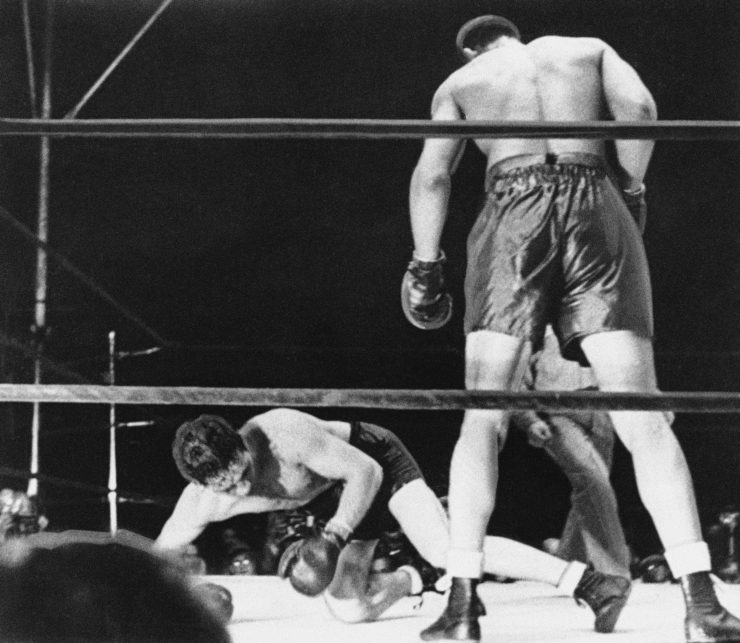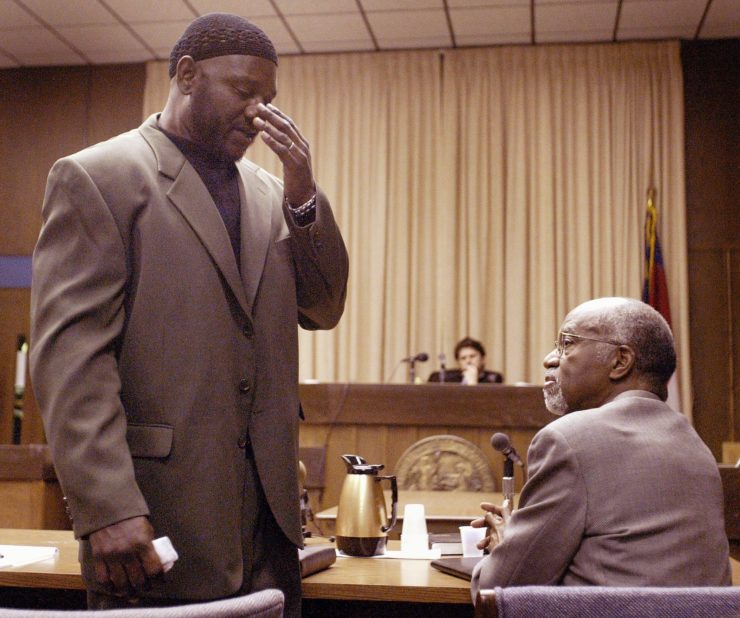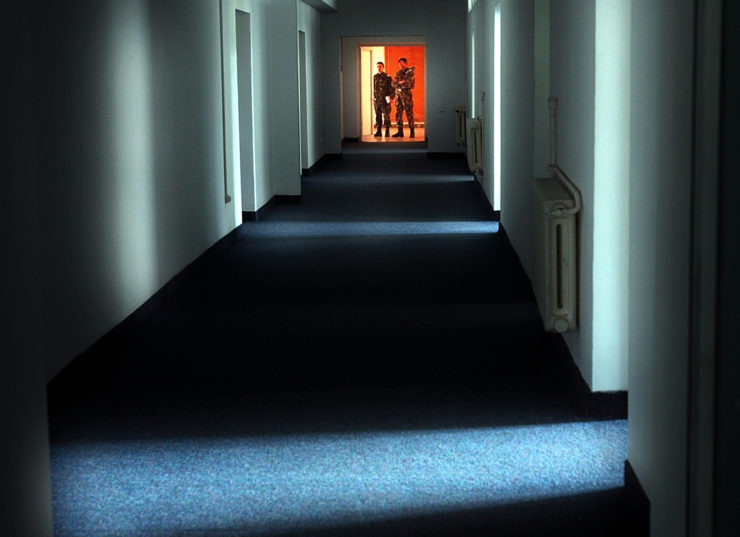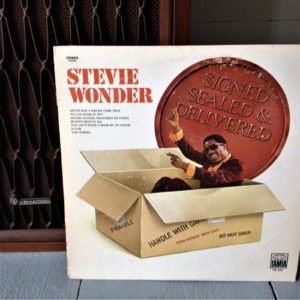
World heavyweight champion Joe Louis, standing, beginning in the 13th round with the challenger, Billy Conn, June 18, 1941. The fight features prominently in a wonderful profile of Conn by the late Frank Deford.
Two journalist heroes are featured in this week’s posts. One of them, literary sportswriter Frank Deford, died this week, and I’m not sure we’ll see his like again. Read the One Great Sentence below and see if you agree. And Washington Post reporter Dana Priest, who has won two Pulitzers and been called a traitor by those who opposed her reporting on the CIA’s “black site” prisons, is beyond bad-ass. Here, she talks about her amazing 30-year career.

Darryl Hunt wipes his face as he addresses the family of Deborah Sykes after being freed in 2004 after serving 18 years for Sykes' killing,
Phoebe Zerwick and “The Last Days of Darryl Hunt.” When Phoebe Zerwick wrote a series of stories that helped exonerate a man wrongfully convicted of murder, everyone loved the happy ending. But Darryl Hunt’s real ending wasn’t a happy one: dead, of a self-inflicted gunshot wound. She decided to tell his story this time. “The stories we told shaped Hunt’s life,” she wrote. “Convicted him. Set him free. Made him a champion of justice. But his death seemed to be telling us that these narratives missed something. They didn’t exactly lie, but they weren’t the entire truth either,” she continued. “That’s the trouble with storytelling. This is my attempt to get the story straight.” And I have to pass along a great bit advice from the interview with her: “The basics still hold: Triple, quadruple check everything. And talk to people. All kinds of people.”
The soundtrack: “Me and Bobby McGee,” by Kris Kristofferson. I chose this for its famous chorus, “freedom’s just another word for nothing to lose.” Kristofferson is such a brilliant songwriter; not many songs are as beautifully written as “Sunday Morning Coming Down.”
One Great Sentence
“He had gone into another room, to where the buffet was, after he had watched the 12 rounds when he was the heavyweight champeen of the world, back in that last indelible summer when America dared yet dream that it could run and hide from the world, when the handsomest boy loved the prettiest girl, when streetcars still clanged and fistfights were fun, and the smoke hung low when Maggie went off to Paradise.”
Frank Deford, “The Boxer and The Blonde,” Sports Illustrated, June 17, 1985. Read why we think it’s great.

One of the "black site" prisons used by the CIA to interrogate terrorism suspects. This one, shown in 2005, is an air base in Romania.
Dana Priest and the “terrorism industrial complex” post 9/11: Dana Priest knows a thing or two about taking on secretive presidential administrations. She says: “Directly after 9/11, the media climate became ‘wrapped up in the flag,’ meaning if a journalist questioned what the Bush administration was doing to keep us safe from terrorism, it meant that he or she was not patriotic. Joe Scarborough actually said on the air, if ‘planes fly into buildings, blame Dana Priest.’ NBC made him apologize, but it wasn’t the first time I was called a traitor.”
The soundtrack: “Reason Is Treason,” by Kasabian. As the Brits would say, this is a proper rock band. And this could be the journalists’ credo, no? “Check the angles from both forces/ Overcome by the need to fight it/Fight it fight it fight it fight it.”
What I’m reading online: “Silicon Valley Murder Mystery: How Drugs and Paranoia Doomed Silk Road.” Vanity Fair ran an excerpt of Nick Bilton’s book on the young founder of Silk Road, and his descent from college-kid Ayn Rand follower to billionaire tech overlord to a man who ordered hits on people who crossed him. Talk about a narrative arc.
I loved the “Fahrenheit 451” vibe of this publishing-as-performance-art outfit that prints books only during the full moon, and only in batches of 69, and then burns any that don’t sell the same night. As the Guardian piece says, “While most books can survive centuries or even millennia, Tunglið – as its two employees tell me – ‘uses all the energy of publishing to fully charge a few hours instead of spreading it out over centuries … For one glorious evening, the book and its author are fully alive. And then, the morning after, everyone can get on with their lives.'”
Speaking of writing that survives centuries, a new biography of famous naturalist Henry David Thoreau sounds fascinating. As the wonderfully bylined Jedediah Purdy writes in The Nation:Thoreau found that the political was personal, and although he hated it for that, because his first attachment was to the personal, he was too honest to pretend otherwise. So he turned it into an art, a means of making sense of his world. He wrote about being trapped in America and in a beautiful, half-ruined world whose beauty and ruin were inseparable.”
 What’s on my bedside table: “Onward and Upward in the Garden,” by Katharine S. White. Her husband, E.B. White, may be more famous, but Katharine White was an amazing woman. She began working at The New Yorker in 1925, the year of its founding, and was the fiction editor there for nearly 35 years. She also loved gardening in Maine’s precious growing season. One essay begins, “It is late August as I begin this report. The days, here in Maine, are noticeably shorter, and lovely summer slips through the hand like Edna Millay’s silver fish.” Also worth reading is E.B. White’s introduction.
What’s on my bedside table: “Onward and Upward in the Garden,” by Katharine S. White. Her husband, E.B. White, may be more famous, but Katharine White was an amazing woman. She began working at The New Yorker in 1925, the year of its founding, and was the fiction editor there for nearly 35 years. She also loved gardening in Maine’s precious growing season. One essay begins, “It is late August as I begin this report. The days, here in Maine, are noticeably shorter, and lovely summer slips through the hand like Edna Millay’s silver fish.” Also worth reading is E.B. White’s introduction.
 What’s on my turntable: “Signed, Sealed & Delivered,” by Stevie Wonder. What’s not to love about a cover that shows Wonder (wearing a fabulous velvet sport coat and frilly orange cuffs) sitting in a box with the words “HANDLE WITH CARE” and “FROM DETROIT WITH LOVE”? OK, how about the title song? Which, oddly, doesn’t have the ampersand in the title. But I’m also pretty fond of his soulified cover of the Beatles’ “We Can Work It Out.”
What’s on my turntable: “Signed, Sealed & Delivered,” by Stevie Wonder. What’s not to love about a cover that shows Wonder (wearing a fabulous velvet sport coat and frilly orange cuffs) sitting in a box with the words “HANDLE WITH CARE” and “FROM DETROIT WITH LOVE”? OK, how about the title song? Which, oddly, doesn’t have the ampersand in the title. But I’m also pretty fond of his soulified cover of the Beatles’ “We Can Work It Out.”
If you want to chat about storytelling (or music), I’m Storyboard editor Kari Howard, and you can reach me at editor@niemanstoryboard.org. Or you can find me at @karihow on Twitter.


